Cognitive Warfare: Manipulating numbers to influence global public opinion. How Hamas deceived western media.
by Claudio Bertolotti
Excerpted from the book by C. Bertolotti (2024), Gaza Underground: The Underground and Urban Warfare between Israel and Hamas. History, Strategies, Tactics, Cognitive Warfare, and Artificial Intelligence, ed. START InSight, Lugano, pp. 325. [GO TO BOOK].
Introduction
In the digital age, warfare transcends mere physical confrontation. Enter the realm of “cognitive warfare,” a sophisticated strategy aimed not just at battles on the ground, but at the very fabric of human perception and behavior. Cognitive warfare is characterized by the utilization of advanced technologies and psychological methodologies to penetrate individual consciousness.
This approach surpasses conventional disinformation or propaganda tactics; it encompasses the utilization of artificial intelligence and machine learning algorithms to sway thought processes and decision-making mechanisms without explicit authorization (Farwell, 2020). This form of warfare exploits the susceptibilities of contemporary societies to information overload, utilizing the same platforms that facilitate global communication and access to information to disseminate content aimed at causing instability. This article examines how Hamas, a non-state actor designated as a terrorist organization by several countries, has embraced cognitive warfare strategies to further its geopolitical, economic, and social goals. Through a case study of the ongoing conflict between Israel and Hamas and theoretical analysis, we delve into the utilization of these tactics in a hybrid conflict context marked by manipulation (Bachmann, 2024).
This article, drawn from the research compiled in my latest book “Gaza Underground: la guerra sotterranea e urbana tra Israele e Hamas” (Bertolotti, 2024), not only highlights the destructive capabilities of cognitive warfare but also promotes a critical debate on the international norms and policies necessary to regulate the use of cognitive technologies in wartime contexts.
Cognitive warfare represents a critical and disturbing frontier in modern conflict. Our understanding of this phenomenon is essential for the protection of democracies and for maintaining global peace and stability.
How does Hamas influence public opinion?
During the conflict with Israel, Hamas has employed diverse cognitive warfare strategies to sway public opinion, targeting both Arab-Muslim and Western audiences to garner support for its cause. Central to these efforts is the utilization of symbols and narratives by Hamas, aimed at evoking empathy or backing for their objectives. This deliberate selection of symbols and narratives seeks to forge an emotional connection between the public and Hamas’s struggle, thereby shaping individuals’ perceptions through emotional alignment with the organization’s cause.
Additionally, online activities have emerged as a crucial tactic for Hamas. The group has adeptly leveraged digital platforms to disseminate its messages, engage with public sentiment, and coordinate propaganda campaigns. This virtual presence has enabled Hamas to extend its reach to a global audience.
Furthermore, Hamas has employed the staging of media events as another strategic tool. These orchestrated events are cynically designed to generate extensive and favorable media coverage, eliciting emotions of outrage towards Israel and solidarity with the Palestinians. By framing these events within a narrative supportive of Hamas’s cause and intertwining them with the broader “Palestinian cause,” Hamas aims primarily at an international audience, seeking to shape global public opinion. The overarching objective is to garner international support through the involvement of international organizations, governments, and lobbying groups, thereby influencing the global perception of the conflict.
In summary, through the coordinated deployment of these strategies, Hamas has endeavored to shape public perception at both local and international levels, with the aim of mobilizing widespread support against Israel.
One of the primary strategies employed by Hamas involves media propaganda, utilizing various channels to disseminate a favorable portrayal of their cause. Through mediums such as interviews, press releases, and other communication channels, Hamas officials have actively sought to shape public perception in their favor. Throughout the conflict, Hamas has exploited media platforms to circulate imagery and narratives aimed at eliciting empathy and garnering support for their agenda. This includes the presentation of images depicting civilian casualties and dramatic scenarios, often devoid of contextualization or presented with fragmented information.
Moreover, Hamas has extensively employed disinformation as a tactical approach, deliberately disseminating false or misleading information to sow confusion and manipulate public perception of events. This strategy has contributed to an environment characterized by a blurred truth, casting doubt on the credibility of information sources and complicating public comprehension of factual details.
For instance, the so-called Ministry of Health in Gaza, effectively under the control of Hamas, claimed a death toll of over 30,000, predominantly comprising women and children, as of March 1, 2024. Is this assertion credible? No, it is not. Abraham Wyner, Professor of Statistics and Data Science at the Wharton School of the University of Pennsylvania and co-director of the faculty of Sports Analytics and Business Initiative, conducted a study on this issue using data provided by Hamas from October 26 to November 10, 2023, published in a condensed form in the article “How the Gaza Ministry of Health Fakes Casualty Numbers. The evidence is in their own poorly fabricated figures“, the conclusions of which are summarized here (Wyner 2024).
The count of civilian casualties in Gaza has garnered global attention since the onset of the conflict. The primary source cited by the media and international politics is the Gaza Health Ministry, which is under the control of Hamas. As of March 1, 2024, they reported over 30,000 deaths, with the majority being children and women. The U.S. administration, led by President Joe Biden, has endorsed these figures. During a hearing at the House Armed Services Committee in late February, Secretary of Defense Lloyd Austin stated that the number of Palestinian women and children killed since October 7 exceeded 25,000, citing an estimate from the Hamas-controlled Gaza Health Ministry. President Biden had previously referenced this figure, underscoring that “too many” of the over 27,000 Palestinians killed in the conflict were innocent civilians and children. A subsequent White House press release affirmed that the president had relied on publicly available data regarding the total number of casualties (Wyner, 2024).
The discrepancy within this dataset is evident: the figures are not accurate. An examination of the available data and information indicates that the majority of the casualties are not women and children, but rather combatants affiliated with Hamas. Should there be any manipulation or fraudulence in Hamas’s data, this can be substantiated through a thorough analysis of the dataset itself. Despite its limitations, the available data is adequate for this purpose. Let us delve into how Wyner (2024) confirmed the reliability of this dataset.
From October 26 to November 10, 2023, the Gaza Health Ministry disseminated daily casualty reports, encompassing both the total count and specific figures for women and children. Wyner’s initial focus was on the aggregate number of reported fatalities, which, as depicted in Figure 1, exhibits a consistent, nearly linear progression over the given period (Wyner 2024).
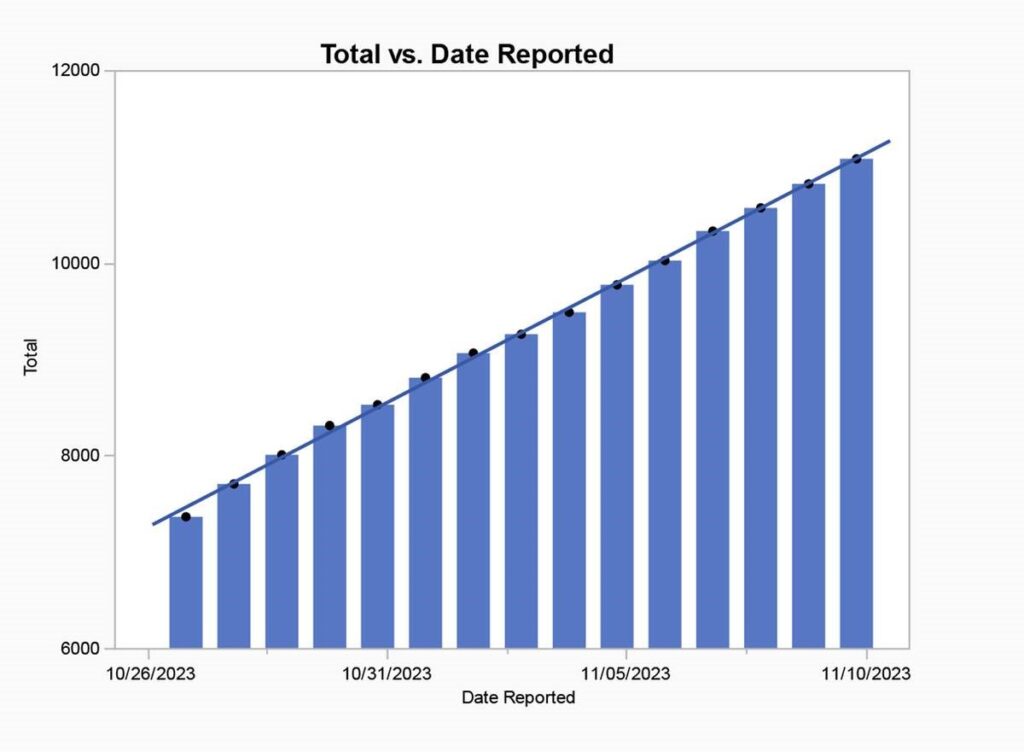
Figure 1. The chart reveals an extremely regular increase in casualties over the considered period. The aggregated data by Wyner, provided by the United Nations Office for the Coordination of Humanitarian Affairs (OCHA), are based on figures from the Gaza Health Ministry (Source: Tablet Magazine).
The consistency observed in the pattern of fatalities reveals incongruities that indicate a significant lack of authenticity. Put differently, they appear to be deceptive. One would anticipate some degree of day-to-day fluctuation, yet the average daily casualty figure during the examined period hovers around two hundred seventy, with a variation of merely fifteen percent. This remarkably minimal fluctuation is unexpected, as one would anticipate days with substantially higher-than-average counts (or conversely, lower-than-average counts). This suggests the likelihood that the Gaza ministry has disseminated falsified daily figures, exhibiting insufficient variation compared to typical statistical patterns. Such uniformity may result from a misunderstanding of the natural variability inherent in data generation processes. Even without verified control data, the specifics of the daily counts raise significant suspicions regarding the accuracy of the numbers (Wyner, 2024).
Going into further detail, Wyner (2024) observes that we should anticipate fluctuations in the number of child casualties that correspond to variations in the number of women casualties. This is because daily changes in death tolls are driven by fluctuations in attacks on residential buildings and tunnels, which should lead to significant variability in overall counts but with less variability in the proportion of deaths among demographic groups (men, women, children): it’s a fundamental statistical principle concerning random variation. Therefore, days with high female casualties should also see high numbers of child casualties, while days with low female casualties should correspond to fewer reported child casualties. This association can be assessed and quantified using the coefficient of determination (R-squared), which indicates the level of correlation between daily counts of female casualties and daily counts of child casualties. In the case of genuine data, one would expect an R-squared value substantially greater than 0, approaching 1.0. However, the R-squared coefficient, as depicted in Figure 2, stands at 0.017, a value that statistically and substantively does not deviate from 0 (Wyner, 2024).
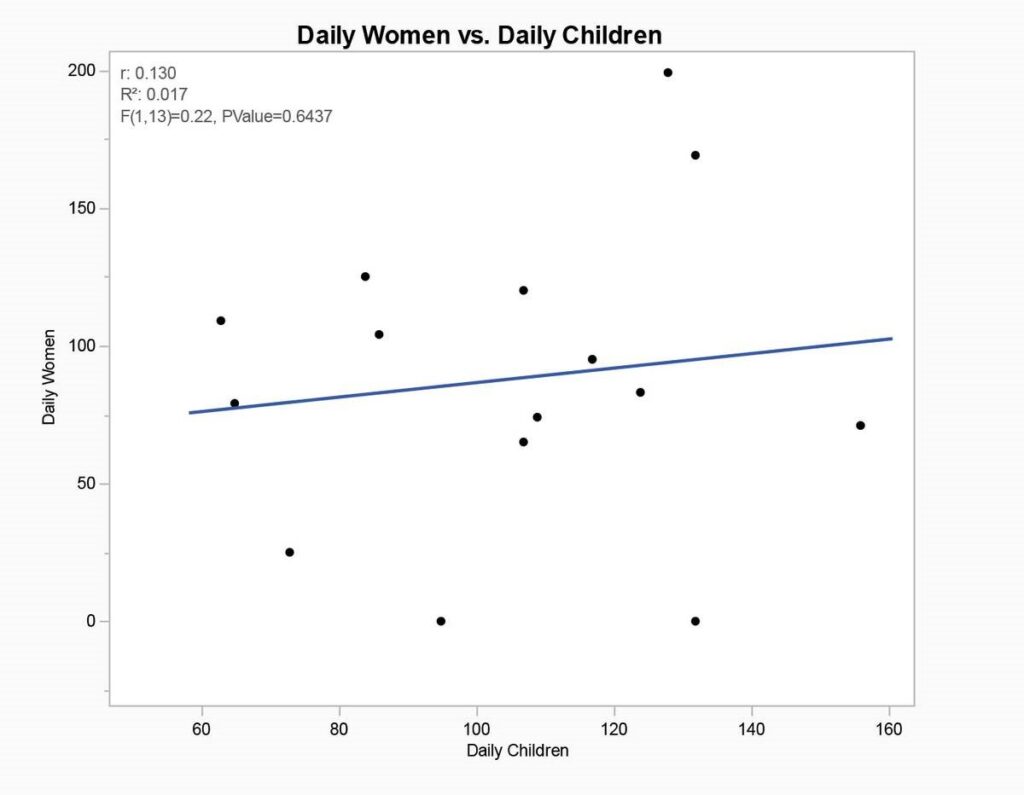
Figure 2. The daily count of children reported as killed has no relationship with the number of women reported. The R-squared coefficient is 0.017, and the relationship is statistically and substantively insignificant (Source: Tablet Magazine).
The lack of correlation serves as the second piece of circumstantial evidence indicating the potential falsity of the numbers reported by the Ministry of Health of Gaza. An in-depth examination necessitates taking into account an additional significant factor: considering the conflict dynamics, one would anticipate a close relationship between the daily number of female and male casualties, excluding women and minors. This assumption stems from the expectation that changes in the frequency and intensity of bombings and attacks would affect the daily counts of both sexes uniformly. Contrary to this expectation, data analysis does not show a direct correlation; instead, it reveals a strong inverse correlation (as shown in the graph in Figure 2). This finding contradicts the predictions and further suggests that the reported data may not be accurate, providing a third piece of evidence supporting the potential inauthenticity of the figures reported.
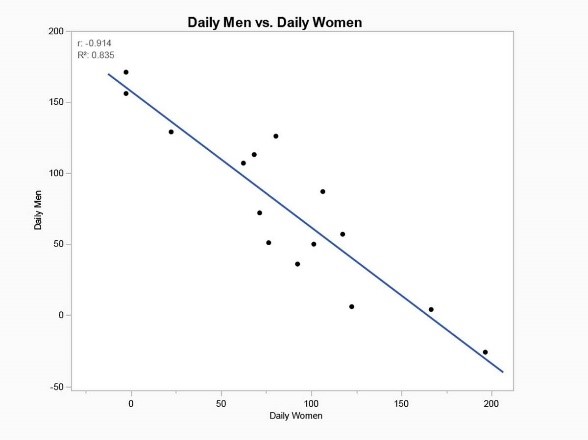
Figure 3. The correlation between the daily count of deceased men and the daily count of deceased women is extremely strong and negative (p-value < 0.0001) (Source: Tablet Magazine).
Wyner (2024) identified further discrepancies within the analyzed data: for example, the male casualty numbers reported on October 29 appear to contradict those from the previous day, suggesting the paradoxical possibility that twenty-six men might have come back to life, or more plausibly, that there were attribution or recording errors. Additionally, there are days when the reported number of male casualties is strikingly low, almost nonexistent; if these were simple recording errors, one would expect the number of female casualties to be average, at least. However, the article’s Author points out that on the three days where the male casualty count is nearly zero, suggesting a potential error, the number of female casualties is notably high. Interestingly, the three highest daily peaks of female casualties occur on these anomalous days, as shown in the graph in Figure 3 (Wyner 2024).
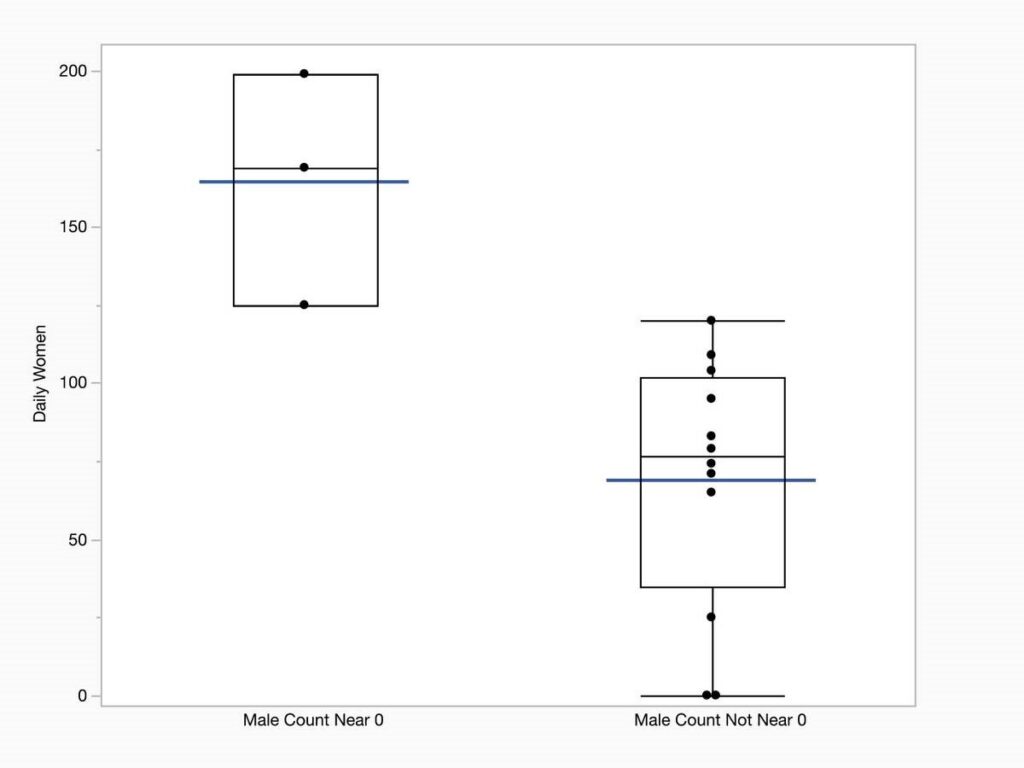
Figure 4. There are three days where the count of male casualties is close to zero. These three days correspond to the three highest daily counts of female casualties (Source: Tablet Magazine).
What conclusions can be drawn from these observations? While not definitive, the evidence strongly suggests that the figures were generated using a method that is minimally, if at all, linked to actual events. It appears probable that the Hamas Ministry of Health arbitrarily determined a daily total number of casualties. This deduction stems from the excessively consistent increases in the daily totals, which raises doubts about their reliability. Subsequently, approximately seventy percent of these totals seem to have been randomly allocated between women and children, with this distribution changing daily. Lastly, the male casualty figures were likely adjusted to align with the pre-determined total. Such an approach could explain the observed inconsistencies and apparent anomalies in the data (Wyner, 2024).
There are also additional conspicuous “warning signs.” The Ministry of Health in Gaza consistently asserts that approximately seventy percent of the casualties consist of women and children, a proportion markedly higher than those documented in preceding conflicts with Israel. Moreover, given that seventy percent of the casualties are purportedly women and children while adult males comprise twenty-five percent of the population, it strongly implies that the reported figures are, at the very least, substantially inaccurate and likely falsified. Furthermore, on February 15, Hamas publicly acknowledged the loss of 6,000 of its combatants, equating to more than twenty percent of the total casualties reported, further highlighting discrepancies. Put differently, if Hamas claims that seventy percent of the casualties are women and children, alongside twenty percent being combatants, such a scenario appears highly implausible in an urban armed confrontation, unless Israel intentionally avoided targeting non-combatant males, or Hamas implies that nearly all male residents of Gaza are affiliated with Hamas.
Are there alternative datasets available for those seeking to validate the reliability of Hamas’s data? Some impartial observers have conceded that Hamas’s casualty figures in prior conflicts with Israel were relatively accurate. However, the Israel-Hamas conflict that commenced in 2023 differs drastically in scale and magnitude from past events; independent monitors, previously able to oversee clashes between Israel and Hamas, were entirely absent during the recent conflict, rendering reliance on past occurrences as a benchmark impossible. The “fog of war” is particularly dense in Gaza, impeding the swift and precise determination of civilian death tolls. Additionally, official tallies of Palestinian fatalities do not differentiate between combatants and civilians, and Hamas attributes all deaths to Israel, including those resulting from failed Palestinian rocket launches, accidental detonations, intentional homicides, or internal disputes. Substantiating this, an official Hamas document (featured in Figure 4), retrieved by Israeli forces in Gaza, explicitly acknowledges civilian casualties stemming from failed rocket launches by the Palestinian Islamic Jihad group and underscores the intent to ascribe responsibility to Israel.
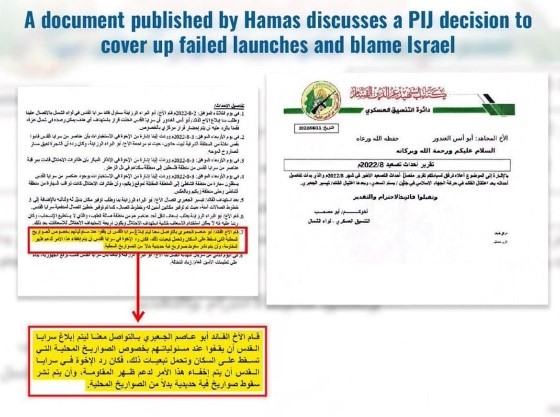
A team of researchers from the Johns Hopkins Bloomberg School of Public Health conducted a comparison between Hamas’s data and information regarding Unrwa (United Nations Relief and Works Agency for Palestine Refugees) workers. They posited that since the mortality rates appeared to be roughly similar, Hamas’s reported numbers would not have been artificially inflated. However, this line of reasoning rests on an unverified assumption: that Unrwa workers are not disproportionately more susceptible to being killed than the general population. Wyner (2024) highlights the potential flaw in this assumption, suggesting that some Unrwa workers may have affiliations with Hamas. This implication gains weight given that some Unrwa workers were involved in the events of the October 7th massacre (Wyner, 2024).
The truth regarding the conflict between Israel and Hamas remains obscured and is likely to remain so. However, it is plausible that the reported total of civilian casualties is significantly inflated. Israel’s estimation of at least 12,000 Palestinian fighters killed suggests that even if this number is reasonably accurate, the ratio between non-combatant and combatant casualties would be remarkably low. This implies a concerted effort to minimize unnecessary loss of civilian life while engaging an adversary intermingled within the civilian populace (Wyner, 2024).
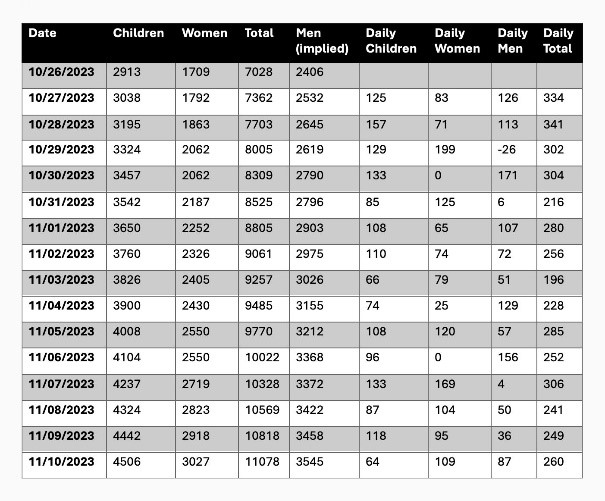
Bibliography
Bachmann S.D. (2024), Hamas-Israel: Tik Tok and the relevance of the cognitive warfare domain, Defense Horizon Journal.
Bertolotti C. (2024), Gaza Underground: la guerra sotterranea e urbana tra Israele e Hamas. Storia, strategie, tattiche, guerra cognitiva e intelligenza artificiale, ed. START InSight, Lugano, pp. 325, in: https://www.amazon.it/dp/8832294230.
Wyner A. (2024), How the Gaza Ministry of Health Fakes Casualty Numbers. The evidence is in their own poorly fabricated figures, The Tablet, march 7th, in https://www.tabletmag.com/sections/news/articles/how-gaza-health-ministry-fakes-casualty-numbers.
Farwell J. (2020), Information Warfare: Forging Communication Strategies for Twenty-first Century Operational Environments, Chicago University Press, Doi:10.56686/9781732003095.

